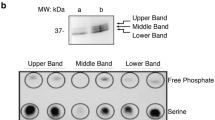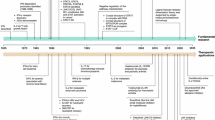Abstract
Cytokines are secreted proteins that regulate important cellular responses such as proliferation and differentiation1. Key events in cytokine signal transduction are well defined: cytokines induce receptor aggregation, leading to activation of members of the JAK family of cytoplasmic tyrosine kinases. In turn, members of theSTAT family of transcription factors are phosphorylated, dimerize and increase the transcription of genes with STAT recognition sites in their promoters1,2,3,4. Less is known of how cytokine signal transduction is switched off. We have cloned a complementary DNA encoding a protein SOCS-1, containing an SH2-domain, by its ability to inhibit the macrophage differentiation of M1 cells in response to interleukin-6. Expression of SOCS-1 inhibited both interleukin-6-induced receptor phosphorylation and STAT activation. We have also cloned two relatives of SOCS-1, named SOCS-2 and SOCS-3, which together with the previously described CIS (ref. 5) form a new family of proteins. Transcription of all four SOCS genes is increased rapidly in response to interleukin-6, in vitro and in vivo, suggesting they may act in a classic negative feedback loop to regulate cytokine signal transduction.
This is a preview of subscription content, access via your institution
Access options
Subscribe to this journal
Receive 51 print issues and online access
$199.00 per year
only $3.90 per issue
Buy this article
- Purchase on SpringerLink
- Instant access to full article PDF
Prices may be subject to local taxes which are calculated during checkout





Similar content being viewed by others
References
Nicola, N. A. Guidebook to Cytokines and Their Receptors (Oxford Univ. Press, Oxford, (1994)).
Ihle, J. N. Cytokine receptor signalling. Nature 377, 591–594 (1995).
Ihle, J. N., Witthuhn, B. A., Quelle, F. W., Yamamoto, K. & Silvennoinen, O. Signaling through the hematopoietic cytokine receptors. Ann. Rev. Immunol. 13, 369–398 (1995).
Darnell, J. J, Kerr, I. M. & Stark, G. R. Jak-STAT pathways and transcriptional activation in response to IFNs and other extracellular signaling proteins. Science 264, 1415–1421 (1994).
Yoshimura, A. et al. Anovel cytokine-inducible gene CIS encodes an SH2-containing protein that binds to tyrosine-phosphorylated interleukin 3 and erythropoietin receptors. EMBO J. 14, 2816–2826 (1985).
Metcalf, D., Hilton, D. J. & Nicola, N. A. Clonal analysis of the actions of the murine leukemia inhibitory factor on leukemic and normal murine hemopoietic cells. Leukemia 2, 216–221 (1988).
Lotem, J., Shabo, Y. & Sachs, L. Clonal variation in susceptibility to differentiation by different protein. Leukemia 3, 804–807 (1989).
Rayner, J. R. & Gonda, T. J. Asimple and efficient procedure for generating stable expression libraries by cDNA cloning in a retroviral vector. Mol. Cell. Biol. 14, 880–887 (1994).
Schlueter, G. et al. Sequence analysis of the conserved Protamine gene cluster shows that it contains a fourth expressed gene. Mol. Reprod. Dev. 43, 1–6 (1996).
Feng, J. et al. Activation of JAK2 catalytic activity requires phosphorylation of Y1007 in the kinase activation loop. Mol. Cell. Biol. (in the press).
Endo, T. A. et al. Anew protein containing an SH2 domain that inhibits JAK kinases. Nature 387, 921–924 (1997).
Rasko, J. E., Metcalf, D., Rossner, M. T., Begley, C. G. & Nicola, N. A. The flt3/flk-2 ligand: receptor distribution and action on murine haemopoietic cell survival and proliferation. Leukemia 9, 2058–2066 (1995).
Smith, A., Metcalf, D. & Nicola, N. A. Cytoplasmic domains of the common β-chain of the GM-CSF/IL-3/IL-5 receptors that are required for inducing differentiation or clonal suppression in myeloid leukaemic cell lines. EMBO J. 16, 451–464 (1997).
Ihle, J. N. et al. Protein tyrosine phosphorylation in the regulation of hematopoiesis by receptors of the cytokine-receptor superfamily. Blood Cells 20, 65–80 (1994).
Yi, T., Mui, A. L., Krystal, G. & Ihle, J. N. Hematopoietic cell phosphatase associates with the interleukin-3 (IL-3) receptor beta chain and down-regulates IL-3-induced tyrosine phosphorylation and mitogenesis. Mol. Cell. Biol. 13, 7577–7586 (1993).
Mui, A. L., Wakao, H., Kinoshita, T., Kitamura, T. & Miyajima, A. Suppression of interleukin-3-induced gene expression by a C-terminal truncated Stat5: role of Stat5 in proliferation. EMBO J. 15, 2425–2423 (1996).
Quelle, F. W. et al. Erythropoietin induces activation of Stat5 through association with specific tyrosines on the receptor that are not required for a mitogenic response. Mol. Cell. Biol. 16, 1622–1631 (1996).
Hilton, D. J. et al. Cloning of a murine IL-11 receptor alpha-chain; requirement for gp130 for high affinity binding and signal transduction. EMBO J. 13, 4765–4775 (1994).
Pearson, W. R. & Lipman, D. J. Improved tools for biological sequence comparison. Proc. Natl Acad. Sci. USA 85, 2444–2448 (1988).
Pearson, W. R. Rapid and sensitive sequence comparison with FASTP and FASTA. Methods Enzymol. 183, 63–98 (1990).
Altschul, S. F., Gish, W., Miller, W., Myers, E. W. & Lipman, D. J. Basic local alignment search tool. J. Mol. Biol. 215, 403–410 (1990).
Alexander, W. S., Metcalf, D. & Dunn, A. R. Point mutations within a dimer interface homology domain of c-Mpl induce constitutive receptor activity and tumorigenicity. EMBO J. 14, 5569–5578 (1995).
Metcalf, D., Willson, T. A., Hilton, D. J., DiRago, L. & Mifsud, S. Production of hematopoietic regulatory factors in cultures of adult and fetal mouse organs: measurement by specific bioassays. Leukaemia 9, 1556–1564 (1995).
Hilton, D. J., Watowich, S., Katz, L. & Lodish, H. F. Saturation mutagenesis of the WSXWS motif of the erythropoietin receptor. J. Biol. Chem. 271, 4699–4708 (1996).
Nicola, N. A., Viney, E., Hilton, D. J., Roberts, B. & Willson, T. Cloning of two novel transmembrane ligands for eph-related linases (LERKs) that are related to LERK2. Growth Factors 13, 141–149 (1996).
Novak, U. et al. Colony-stimulating factor 1-induced STAT1 and STAT3 activation is accompanied by phosphorylation of Tyk2 in macrophages and Tyk2 and JAK1 in fibroblasts. Blood 86, 2948–2956 (1995).
Naka, T. et al. Structure and function of a new STAT-induced STAT inhibitor. Nature 387, 924–929 (1997).
Acknowledgements
We thank R. Simpson and R. Moritz for recombinant mouse IL-6, C. McFarlane for help with production of recombinant cytokines, S. Cory for the pPGKpuropA vector, P. Lock for the pPGKneo vector and U. Novak for her generous advice regarding electrophoretic mobility shift assays. B.Roberts, D. Cary, L. Di Rago, S. Mifsud and N. Sprigg are thanked for their excellent technical assistance. D.J.H. was supported by a Queen Elizabeth II Postdoctoral Fellowship from the Australian Research Council. T.J.G. is a senior research fellow of the NH & MRC. This work was supported by the Anti-Cancer Council of Victoria, Melbourne, Australia, AMRAD Operations Pty Ltd, Melbourne, Australia, The National Health and Medical Research Council, Canberra, Australia, The J.D. and L. Harris Trust, the National Institutes of Health, Bethesda, Maryland and the Australian Federal Government Cooperative Research Centres Programme.
Author information
Authors and Affiliations
Corresponding author
Rights and permissions
About this article
Cite this article
Starr, R., Willson, T., Viney, E. et al. A family of cytokine-inducible inhibitors of signalling. Nature 387, 917–921 (1997). https://doi.org/10.1038/43206
Received:
Accepted:
Issue Date:
DOI: https://doi.org/10.1038/43206



